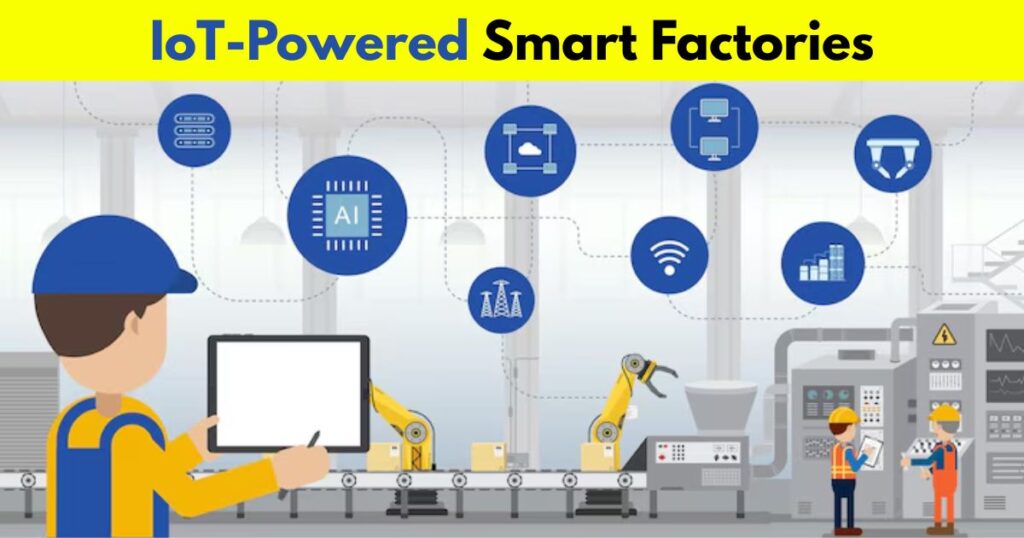The rise of the Industrial Internet of Things (IIoT) is reshaping manufacturing. As of 2024, over 70% of global manufacturers have adopted some form of IoT technology, according to McKinsey. Another report by Statista forecasts the global IoT in manufacturing market will surpass $200 billion by 2026.
This shift is not a trend—it’s a transformation. Companies partner with an experienced IoT App Development Company to build secure, scalable, and data-driven factory systems. In this article, we explore the key components, benefits, technologies, and real-world applications of IoT in smart factories.
What Is a Smart Factory?
A smart factory uses IoT-enabled devices, sensors, and software to collect and analyze real-time data. These systems improve visibility, automate operations, and reduce downtime.
Smart factories rely on:
- IoT sensors embedded in machinery and equipment
- Cloud and edge computing for processing
- AI algorithms for predictive analytics
- Central dashboards for monitoring and control
Unlike traditional setups, smart factories adapt to dynamic changes. They optimize operations without manual intervention.
Core Technologies Driving Smart Factories
Multiple technologies work together to enable smart manufacturing. Understanding their roles is critical.
1. IoT Sensors
Sensors monitor:
- Temperature
- Vibration
- Humidity
- Machine performance
- Asset location
These sensors provide real-time data, helping detect anomalies early.
2. Edge Computing
Edge devices process data locally, reducing latency. This is vital for time-sensitive applications like quality checks or equipment safety.
3. Cloud Integration
The cloud stores large volumes of manufacturing data. It also facilitates:
- Historical analysis
- Remote access to data
- Software updates
4. Digital Twins
Digital twins are virtual replicas of physical systems. Engineers use them to simulate and test scenarios without disrupting production.
5. AI and Machine Learning
AI systems analyze sensor data to:
- Predict machine failures
- Recommend maintenance schedules
- Optimize energy usage
Role of an IoT App Development Company
A specialized IoT App Development Company designs platforms that connect devices, process data, and present insights. Their role includes:
- Creating real-time dashboards
- Securing data transmission
- Ensuring device interoperability
- Building scalable cloud architectures
They enable manufacturers to gain value from their IoT infrastructure.
Key Benefits of IoT in Manufacturing
Manufacturers investing in IoT see tangible outcomes. The following advantages illustrate its importance.
Real-Time Monitoring
Factory managers monitor production lines in real time. This leads to:
- Immediate fault detection
- Fewer product defects
- Better resource allocation
Predictive Maintenance
IoT sensors collect data on machine wear and performance. AI algorithms predict when maintenance is needed.
Benefits include:
- Reduced unexpected downtime
- Extended equipment lifespan
- Lower repair costs
Quality Control
Computer vision systems check product quality. IoT sensors verify that conditions remain within set parameters.
Energy Efficiency
Sensors monitor energy usage at different production stages. Factories can reduce energy waste and track environmental impact.
Improved Supply Chain
IoT helps track inventory levels, equipment status, and order fulfillment. This enhances decision-making across logistics and procurement.
Real-World Examples of Smart Factories
Example 1: Bosch (Germany)
Bosch adopted IoT across its plants. They connected over 100 production sites using IoT platforms.
Results:
- 25% reduction in machine downtime
- Over $1 billion saved through efficiency gains
Example 2: General Electric (USA)
GE’s Brilliant Factory initiative connects machinery with analytics software.
Key outcomes:
- 20% reduction in maintenance costs
- 10% increase in throughput
Example 3: Tata Steel (India)
Tata Steel uses IoT sensors for temperature and pressure monitoring in blast furnaces.
Benefits:
- Better control of furnace efficiency
- Improved worker safety
Common Challenges in IoT for Manufacturing
Despite the advantages, manufacturers face several challenges.
|
Challenge |
Description |
|
Data Security |
IoT systems are vulnerable to cyberattacks. Strong encryption is essential. |
|
Interoperability |
Devices from different vendors must work together seamlessly. |
|
Legacy Equipment |
Older machines may lack IoT compatibility. |
|
High Initial Investment |
Setup costs can be high, especially for small manufacturers. |
|
Data Overload |
Managing and interpreting large data volumes is complex. |
How IoT Enables Smart Maintenance
Maintenance is critical in manufacturing. Traditional methods follow a fixed schedule. IoT changes this to a predictive model.
Key Features of Smart Maintenance:
- Vibration sensors detect abnormal equipment motion
- AI flags deviations in operating parameters
- Alerts notify engineers before breakdowns occur
This approach saves costs and reduces unplanned downtime.
Example:
A Chinese electronics manufacturer installed temperature and vibration sensors. They reduced equipment failure rates by 30% within six months.
Factory Automation Through IoT
IoT enables automation across different stages of production.
Applications:
- Autonomous robots move goods inside warehouses
- IoT cameras inspect finished goods
- Smart conveyors adjust speed based on workflow
These systems reduce reliance on human labor and improve consistency.
Cybersecurity in Smart Factories
Security remains a top concern. Factories must protect:
- Device communication
- Cloud-based storage
- Access control systems
Security Measures:
- Data encryption (TLS, AES)
- Multi-factor authentication
- Role-based access management
- Secure APIs
Collaborating with a trusted IoT App Development Company ensures robust cybersecurity practices.
Table: Comparison Between Traditional and Smart Factories
|
Feature |
Traditional Factory |
Smart Factory |
|
Monitoring |
Manual |
Real-time sensor-based |
|
Maintenance |
Scheduled |
Predictive with AI |
|
Resource Optimization |
Limited |
Data-driven |
|
Fault Detection |
Reactive |
Proactive |
|
Data Storage |
Paper or local servers |
Cloud and edge-based |
Future Outlook for IoT in Manufacturing
The coming years will see further growth in IoT adoption.
Expected Developments:
- Increased adoption of AI-driven automation
- Use of private 5G networks in factories
- Greater focus on sustainability and emissions tracking
- Enhanced interoperability standards for devices
The World Economic Forum projects that smart factories could add $1.5 trillion to the global economy by 2030.
Conclusion
Smart factories represent the next phase of industrial evolution. IoT enables real-time visibility, predictive maintenance, and automation. Adoption improves productivity, quality, and safety.
Partnering with a professional IoT App Development Company is essential. They provide the tools, architecture, and expertise required for successful implementation. With the right strategy, manufacturers can prepare for a more connected and intelligent future.
Frequently Asked Questions (FAQs)
1. What is the role of IoT in smart factories?
IoT in smart factories connects machines, sensors, and systems to collect real-time data. This enables manufacturers to monitor processes, detect issues early, automate tasks, and improve overall efficiency.
2. How does predictive maintenance work with IoT?
Predictive maintenance uses IoT sensors to track machine conditions like temperature and vibration. AI analyzes this data to forecast equipment failures, helping reduce downtime and maintenance costs.
3. Is IoT secure enough for manufacturing environments?
Yes, but it requires proper safeguards. Security measures include encrypted communication, secure APIs, role-based access, and regular firmware updates. Working with an expert IoT App Development Company ensures compliance and protection.
4. Can legacy equipment be integrated with IoT systems?
Yes, through the use of retrofit IoT solutions like sensor attachments and gateway devices. These allow older machines to transmit data without complete replacement.
5. What are the biggest challenges in implementing IoT in manufacturing?
The main challenges include cybersecurity risks, integration with legacy systems, high initial costs, and managing large volumes of data effectively.
- IoT in Manufacturing: A Complete Guide to Smart Factories and Industrial IoT Solutions
- Explore how IoT transforms manufacturing through smart factories. Learn about key technologies, benefits, challenges, and real-world applications driving industrial innovation.
- IoT in Manufacturing, Smart Factories, Industrial IoT, Factory Automation, Predictive Maintenance, IoT Sensors, Digital Twins, IoT App Development Company, Manufacturing Technology, Industrial Automation
Related posts:
 Why KBH Games Is Perfect for Family-Friendly Online Entertainment
Why KBH Games Is Perfect for Family-Friendly Online Entertainment
 Build a Seamless School Portal with These Powerful Templates
Build a Seamless School Portal with These Powerful Templates
 7 Ways Aerospace Companies Are Using Composites to Elevate Aerial Robotics
7 Ways Aerospace Companies Are Using Composites to Elevate Aerial Robotics
 Best Account Management Software for All Businesses – EmizenTech
Best Account Management Software for All Businesses – EmizenTech
 The Role of an ATS in Onboarding: Bridging the Gap Between Offer and Start Date
The Role of an ATS in Onboarding: Bridging the Gap Between Offer and Start Date
 Benefits of AI-powered CCTV Cameras for Business Surveillance
Benefits of AI-powered CCTV Cameras for Business Surveillance
 Top App Development Agency UK – Transforming Ideas into Apps
Top App Development Agency UK – Transforming Ideas into Apps
 Transforming Oil and Gas Operations in Qatar with Microsoft Dynamics 365 Supply Chain Management
Transforming Oil and Gas Operations in Qatar with Microsoft Dynamics 365 Supply Chain Management







